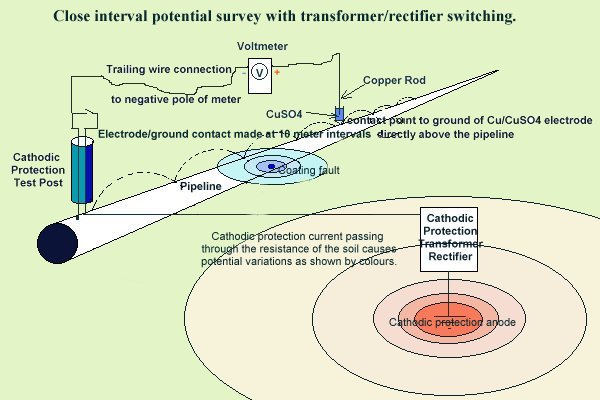Cathodic Protection Network
The difference between Cathodic Protection Network Surveys and others.
Traditional cathodic protection surveys use a team who walk the pipeline wayleave with an assortment of instruments taking readings in a way described by their team leader.
These readings consist of voltages which are sometimes noted by hand but are nowadays recorded using some form of data-logger.
The voltage is the potential difference between a copper/copper-sulphate electrode and the pipeline metal.
The electrode is placed on the ground in a position believed to be over the buried pipeline.
The electrode is then 'stepped' to the next location on the ground sequentially along the pipe route.

It is well known that these voltages contain an error which can be as great as 200%.
A study of this error was made by Mike Foskett of North Thames Gas with the co-operation of Bob Greenwood of the Gas Corporation ERS.
They instituted a program of On Line Inspection Surveys which culminated in gathering millions of voltages over the vast network of steel gas pipelines that serve the North London area of the UK. This survey was composed of four teams of three technicians for four years. The data was stored in the mainframe computer in Thames House Staines.
the founder of the Cathodic Protection Network was a contracted field operative during the final three years of this survey and developed many of the procedures which composed the survey named OLI4.
This has now been adopted world wide and is known as Close Interval Potential Survey (CIPS) This is a misnomer which can be misleading as the values recorded are voltages or potential differences.
An American company called Harco tried later to claim intellectual ownership of one of the procedures but failed.
The two half-cell survey was devised in 1974 by the founder of the CPN whilst trouble shooting in the war damaged oilfields of Nigeria.
It was used extensively in the North Thames Gas surveys to identify the exact location of coating faults where excavations had missed the point when relying on OLI4 techniques.
This type of survey is now practiced world wide called DCVG which is another misnomer. Direct Current Voltage Gradient is confusing and inaccurate as the gradients that it detects are described in a paper presented to the Australasian Corrosion Conference. These are potential gradients and must be refered to a common reference potential to be meaningful.

Cathodic Protection International Ltd will only commision Accredited Members of the CPN to carry out their surveys, using instruments and equipment specifically designed and made by Cathodic Protection International Ltd.
A common zero voltage is used as a reference thoughout the whole of a given survey and therefore the resulting data can be computer analysed.
The CPI Interface Module is the only instrument that the survey team are required to carry. It is a sealed unit which is heat proof to plus or minus the tolerances of human endurance and is virtually indestructable. Spare units are supplied with each team and replacement units are kept in readiness along the chain of supply. Each unit has a unique identity and is self tracking using GPS and mobile phone satelite technology. The unit cannot be opened without self distructing after having broadcast it's last position.
The unit is triggered by fingerprint recognition and communicates with a standard PC by bluetooth.
Voltages are fed into the unit via standard instrument plugs as fitted to the other equipment we supply.
The exact location of the pipeline is defined using a recorded 'Pearson Type' radio wavelength, null-centre technique similar to that which has been used in the pipeline industry for over 50 years.
The survey team are supplied with 'walking stick' type electrodes of patented design to allow the survey to be completed at walking pace over any terain.
The Interface Module tells the survey team when to carry out a 'traverse check' and use the Alexander Cell.
The whole survey is controlled by the data that is being fed into the interface. This data is analysed at the time it is being recorded and operator errors are not acceptable by the system. This may seem like we are anticipating results but this is not so. The results must conform to those resulting from the application of OHMs Law and Kirchoff s Law otherwise they will be rejected. This is not the case with any other survey offered by any other company.
The CPI survey will plot its own progress and show corrosion as it is being revealed. It will allow immediate adjustment of the CP system and a re-run will show the effects of that adjustment.
As the Alexander Cell is corrosion itself we can watch it happening in real time and see it stop.

